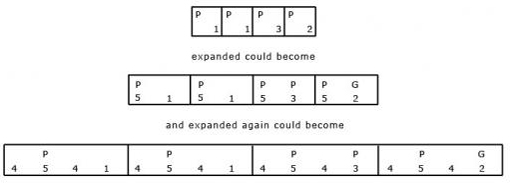3.5 Expansion and contraction of the piece: wilet
It should already be clear that, in order for this music to work, musicians need to listen out carefully for what their colleagues are doing. For instance, since the saron I has at least three possible patterns to play (lancaran, caruk and ciaseman), the saron II player must keep listening in case his colleague changes from one to another. The same ‘interlocking’ principle applies to certain other instalments too. In order to show just how important group interaction is in this music however, it will be necessary to introduce another factor.
It is common practice in Sundanese gamelan music to change the speed of the gong pattern (and, therefore, of the sequence of destination pitches). Say the piece starts with the gong phrase (i.e. the time which elapses between two strikes of the big gong) lasting X seconds. By decelerating, this phrase can be expanded to 2X, 4X or even 8X seconds. A common pattern is for a piece to go through one, two or more such expansions, and then to return by the same stages to the original level (in some cases a higher or extra-fast level, say with a gong phrase of ½X seconds, may also come into play). These different levels are called wilet. It would be a little misleading to think of this shift as simply a change in tempo. In practice, most players will adjust the number of notes they play per cycle so that the tempo – the speed at which the listener feels the music to be moving – does not change as much as these figures would suggest.
Wilet change has something in common with augmentation and diminution in Western music, but is really a process peculiar to south-east Asian music – I like to think of it as analogous to a machine changing gear. Figure 19 demonstrates this shift, with the gong phrase on the top line keeping the same pattern but spreading it over a longer time, while another instrument continues to play notes at the same speed but has time to play more of them in the same basic gong phrase:
and so on. So although the gong pattern becomes more and more sparse, most of the other parts play at much the same speed, but have time for more notes.
(Note: The melodic notations in Figure 19 are not intended as actual instrumental parts; they have been invented to give a clear picture of the process being described.)
This process has various ramifications, but the most important for us here is that it puts an extra burden on group interaction, since (1) the whole group has to expand and contract the pieces together, while (2) the way the piece will work out (how it will be expanded and contracted, and when) is normally decided only in performance. In practice these changes are signalled aurally by the drummer to the rest of the ensemble and the rhythms he plays enable the group to ‘change gear’ in a co-ordinated fashion.
Activity 10
The next section of video (below) illustrates this wilet change in practice. Watch it now and try to follow what happens: although the whole group is playing, the camera focuses on the drummer and gong player to make this easier. If you concentrate on the gong pattern, which should be quite familiar by now, you will notice the decelerations to successive expansions of the piece. The gong-player is following the drummer's cues – cues which are entirely aural.
Demonstration of wilet changes [3 minutes 31 seconds 9.68MB]
Activity 11
Finally, I'd like you to see and hear how all these things come together. The next video sequence shows two extracts of the whole group playing the piece ‘Bendrong’ together, going through a sequence of expansions and contractions. The music is, I think you'll agree, rather complex – but try to remember as you watch, just how simple the underlying structure is! Watch the video clip below now.
Bendrong played by the whole group [4 minutes 52 seconds 13.1MB]

